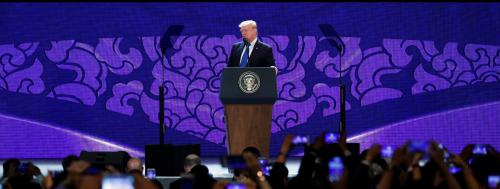Content from the Brookings-Tsinghua Public Policy Center is now archived. Since October 1, 2020, Brookings has maintained a limited partnership with Tsinghua University School of Public Policy and Management that is intended to facilitate jointly organized dialogues, meetings, and/or events.
President Trump’s ambitious 11-day, five-country trip to Asia occurs against the backdrop of yet another bout of regional anxiety over the United States’ commitment to remain an active power in the region. These worries have been exacerbated by U.S. withdrawal from the Trans-Pacific Partnership (TPP) and the Paris climate agreement; its dithering on whether it is worth the president’s time to attend the East Asia Summit; its transactional approach to relationships, including with China; and China’s concurrent efforts to position itself at the center of major regional initiatives.
In light of perceptions of U.S. pullback from regional initiatives and China’s efforts to cast itself as a steady and reliable alternative, questions are mounting about how the region will organize itself in the future. Will the United States continue to set the agenda for developing an integrated and diversified Asia-Pacific, or is the region in the midst of a reversion toward a more hierarchical East Asian community, with China at the top? President Trump’s visit will serve to either allay concerns about American retreat or amplify anxieties about an accelerating power shift.
Trump has an enormous opportunity to exceed expectations and quell concern. He could do so by declaring the United States’ unwavering determination to uphold its alliance commitments, assuring allies and partners that their interests will factor into his approach to regional challenges such as North Korea, articulating a positive vision for how he would like to see the region function, clarifying the type of relationship he seeks with China, and offering tangible proof points of the ways in which the United States is prepared to partner with the region to unlock the talents of its peoples.
Citizens across the continent will follow closely what Trump puts on the table to support Asia’s economic dynamism. Broadly speaking, countries in the Asia-Pacific are naturally inclined to welcome U.S. involvement, given both the United States’ absence of territorial ambitions and its comparative strength in developing human capital and fostering innovation.
Examples of steps Trump could take to fortify U.S. standing in Asia include: committing to work with the region to improve the effectiveness of existing multilateral development banks; announcing that the United States will convene a regional forum to establish and adopt principles and best practices for sustainable infrastructure investment; pledging that the United States will partner with like-minded countries such as Japan and South Korea to launch science and technology skill development programs in Southeast Asia; doubling down on the U.S.-ASEAN Connect program; and setting an ambitious goal for growth in U.S. trade and investment with Southeast Asia over the next five years and designating cabinet-level officials to deliver on it. None of these efforts would be altruistic. They all would contribute to pulling the region closer to the United States and expanding export opportunities for U.S. firms.
At the same time, countries in the region will view warily any attempts by Trump to foster an “us versus them” dynamic that forces a choice between their big and ascendant neighbor, China, and their faraway friend, the United States. Secretary of State Rex Tillerson’s recent call for a concert of democracies to work together to protect freedom and prevent a slide into disorder and conflict risks being perceived as a defensive strategy built on a false choice between supporting America’s vision and acceding to China’s dominance. If the United States pressures countries to choose sides in such a strategy, it likely will be disappointed by the response.
Similarly, if Trump’s overriding messages on the trip are defensive in nature—stopping North Korea’s nuclear and missile programs, slowing China’s ascent, reversing unfair trade relationships between the United States and regional countries—he will have given regional counterparts little to support. Instead, most Asian leaders would like to see Trump take a clear stand in favor of international rules and shared values, and offer tangible backing for greater regional integration and continued economic growth. After all, this is the U.S. formula that has helped undergird regional stability and enable Asia’s economic boom for decades.
Particularly in Southeast Asia, with its young population and optimistic outlook, there will be little enthusiasm for hollow rhetoric about U.S. strength and resolve. Trump’s speech at the APEC CEO Forum in Danang likely will compete for attention against an announcement by the current 11 members of the TPP (minus the United States) about the way forward, and also against Chinese pronouncements on the scale of their plans to invest in regional connectivity through the Belt and Road Initiative.
Bromides about U.S. strength will not compete. No country questions that the United States possesses the most powerful fighting force in the history of humanity. But as impressive as U.S. military power is, it is an insufficient tool of national power for demonstrating that the United States understands the aspirations of the region and is committed to working with countries to improve the lives of their citizens.
If Trump takes the easy path of immersing himself in symbolism about U.S. strength and shows up light on substance, then the chorus warning of the United States losing the long game in Asia will grow louder. Given the increasing importance of Asia to America’s global strategic interests, that is an outcome the United States can ill afford. If, on the other hand, Trump seizes the opportunity of his trip to show that the United States recognizes the importance of Asia to its interests, understands the issues that animate the people of the region, and stands ready to work earnestly with counterparts to support continued stability and prosperity, then his visit will go a long way toward setting the United States on a stronger footing in Asia.









Commentary
Trump’s visit to Asia: Will he choose substance or symbolism?
November 3, 2017